|
|
【中文标题】从卡拉奇到喀布尔的狂野卡车之旅
【原文标题】Road Warriors A reporter's wild truck ride from Karachi to Kabul
【登载媒体】外交政策
【原文链接】http://www.foreignpolicy.com/articles/2013/05/13/road_warriors_khyber_pass_truckers#0
怎么才能保证阿富汗内陆战争的供给呢?2012年秋天,曾经获奖的喀布尔记者马修•艾金斯搭乘一辆快散架的1993年尼桑卡车,延美国军方供给线从港口城市卡拉奇一直进入到巴基斯坦灼热的平原和无法无天的边境地带,途径著名的开伯尔山口,抵达阿富汗战区。一路上,艾金斯遇到了阴险的巴基斯坦承包商、穷凶极恶的警察、目光锐利的收费员。但也有乡下的普什图人,他们在过去十年里陆续离开部落,到大城市从事卡车运输工作——就像他搭乘的卡车主人——一对吸大麻的兄弟。
艾金斯旅程的收获是他的新书《杰曼的鸟和开伯尔的花》——其中部分内容收录在《外交政策》杂志和普利策危机报告中心里,目前有售。这里是艾金斯60天、1000英里历程的部分照片。
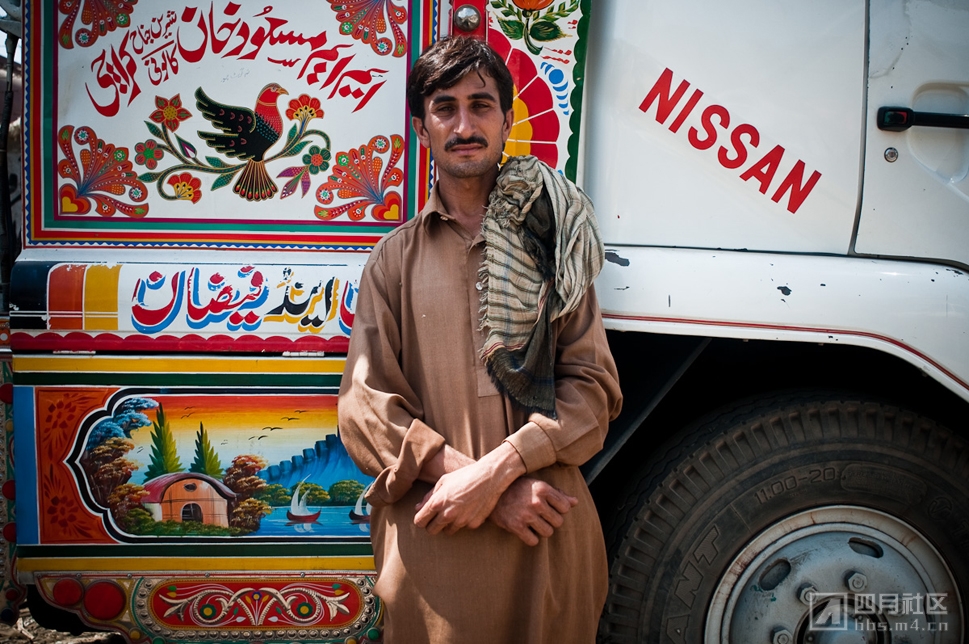
普什图卡车司机有一种传统,他们用色彩亮丽的绘画、金属雕饰和挂在保险杠上的挂饰精心装饰汽车。照片中的人是Omar Azaz,他来自边境城镇蓝地科托,身份是“承包商”,或者也可以说是这辆尼桑油罐车的助理驾驶员。
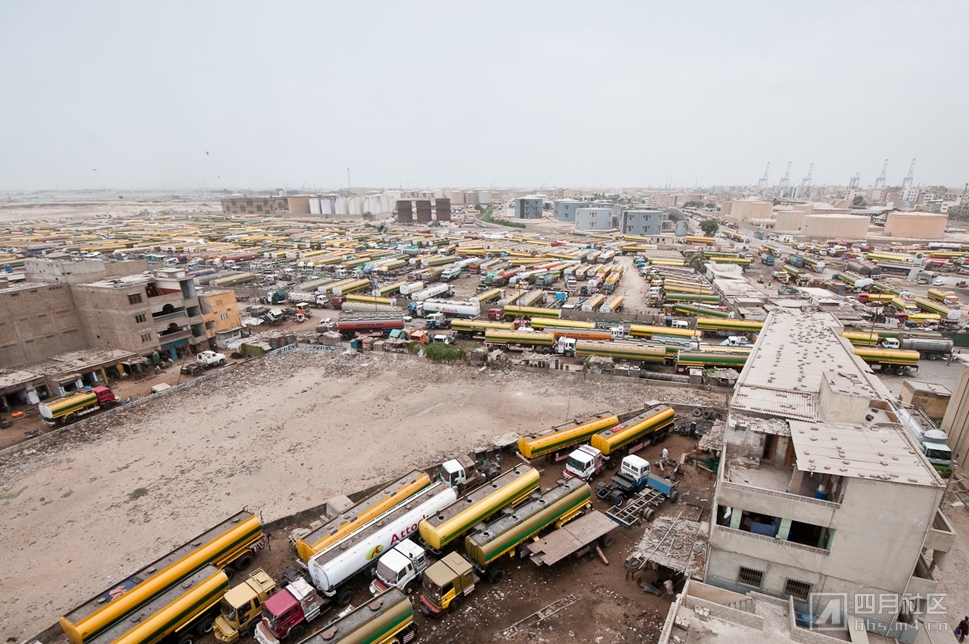
艾金斯的旅程从巴基斯坦最大的城市卡拉奇开始,那里有1600万居民,他找到一辆愿意带他去阿富汗的卡车。上图是这个港口城市希琳真纳殖民地码头的鸟瞰图,这里距石油集散地很近,数百辆油罐车向阿富汗的美军和北约军队运送汽油。
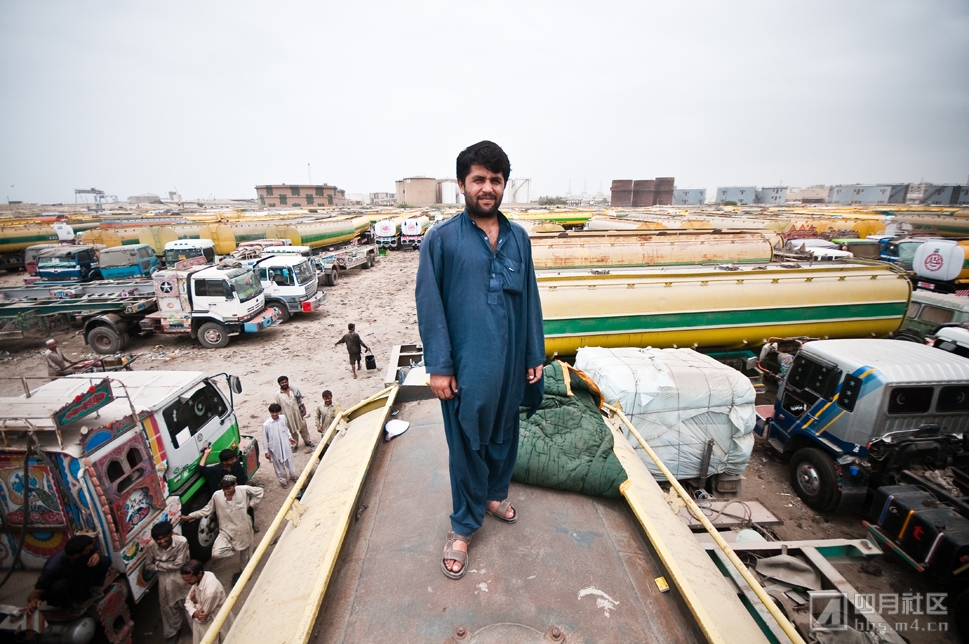
2011年,巴基斯坦政府为了回应美军空袭炸死24名巴基斯坦士兵的事件,关闭了境内两条通往阿富汗的主干道。卡拉奇的很多卡车司机因此失业长达7个月。艾金斯在2012年7月希琳真纳遇到的一位油罐车司机站在车顶,在干道关闭期间,这就是他每晚睡觉的地方。

得益于美国在阿富汗的战争所带来的卡车运输业,尤其是2009年之后的需求猛增,希琳真纳在过去几年里迅速扩张。数千名手艺人和商人——主要是来自西北部部落地区的普什图人——靠卡车运输业谋生。

艾金斯第一次来到卡拉奇是在2012年,两个星期前运输路线刚刚重新开通。但他没能找到一个愿意搭载他的司机,于是他回到了喀布尔。秋天他又来到卡拉奇,集装箱卡车已经开始在边境运输了,但是油罐车司机依然无事可做,因为担心巴基斯坦农村地区的治安情况。
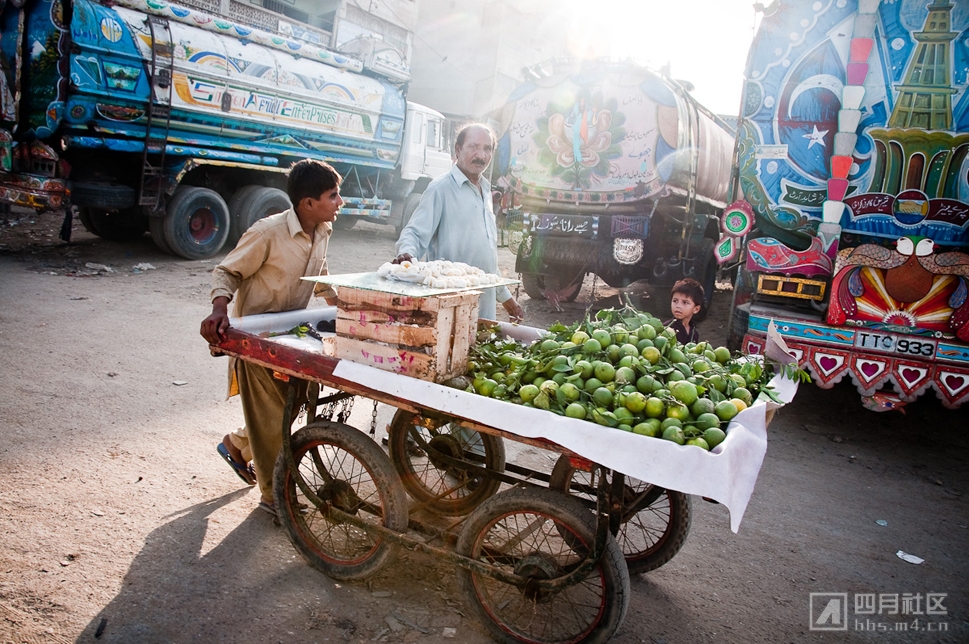
艾金斯在书中写道,道路封闭期间“人们的生计毫无着落,不仅仅是卡车司机,整个经济链都受到冲击——司机助手、商人、轮胎店、旅馆、水果小贩、卡车绘画艺术家、屠夫。”睡在车顶的Azim Khan对艾金斯说:“甚至毒贩子都没有生意。”
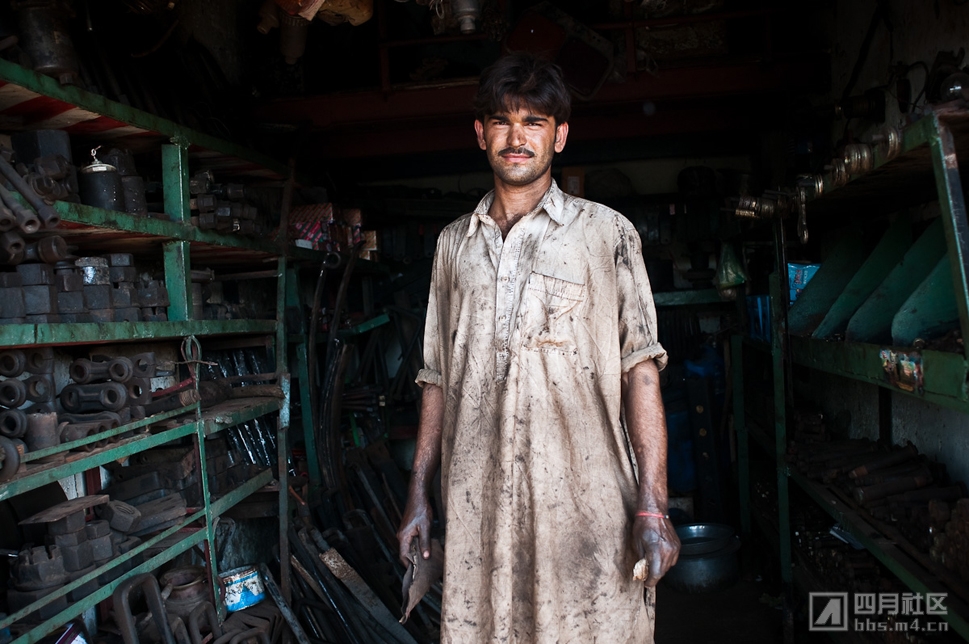
Nasir Khan是来自普什图边境城镇蓝地科托的技师学徒,他来到卡拉奇找工作。
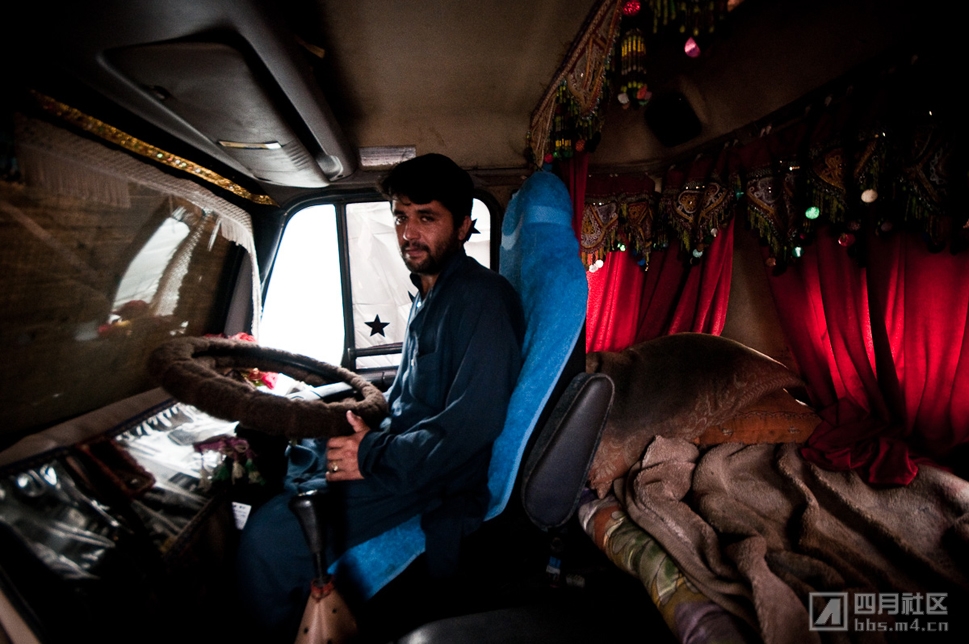
Azim Khan坐在油罐车的驾驶室里。
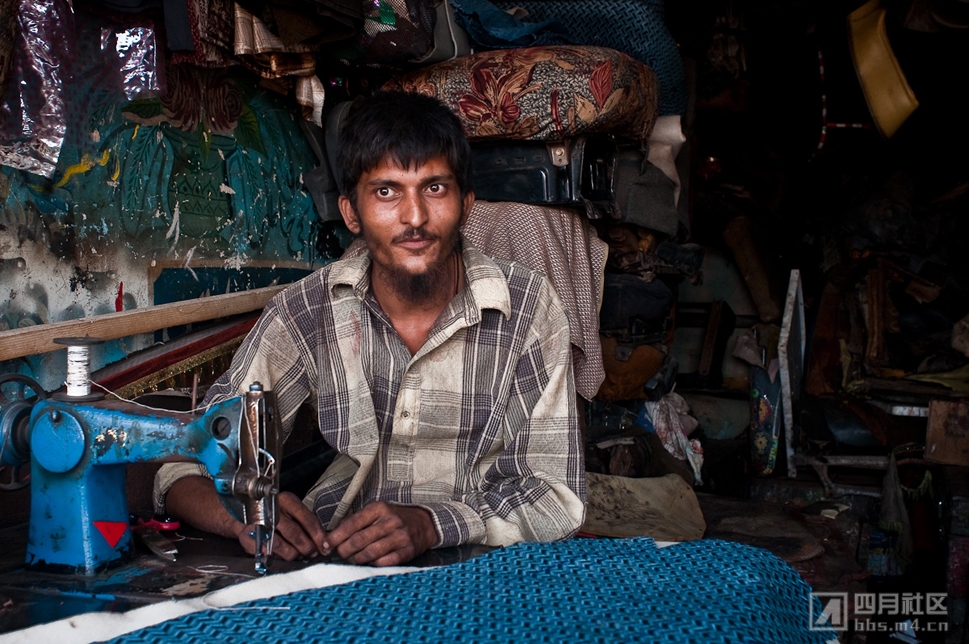
操旁遮普语的Abdul Nisar来自拉合尔,他在缝制汽车坐垫。他对艾金斯说:“北约重新开始行动之后,生意非常好。”
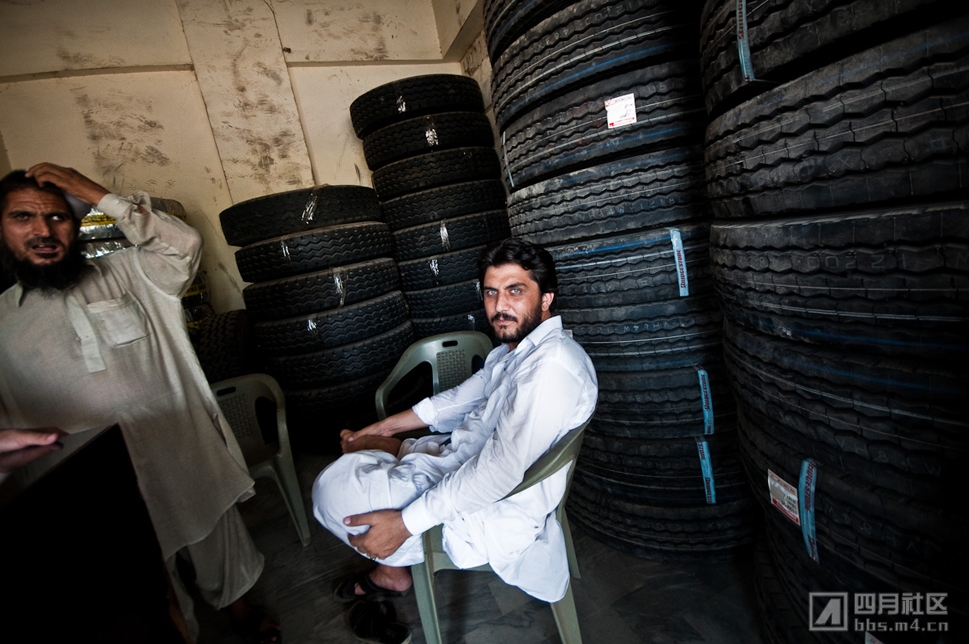
Ibrahim来自巴基斯坦西北部的丹格区,在希琳真纳出售轮胎。他告诉艾金斯,去年的销售量下降了一半。

Sayed Saifullah(中)和他的儿子——18岁的Fareed和9岁的Jahangir——站在他们的轮胎店里。孩子的母亲还住在基达郊外的农村。他们和卡拉奇的父亲挤在一间公寓里。

一个普什图男孩在希琳真纳的街道上奔跑。数以千计的普什图人从部落地区移居到卡拉奇找工作,这改变了这个城市的种族平衡和政治领导力。
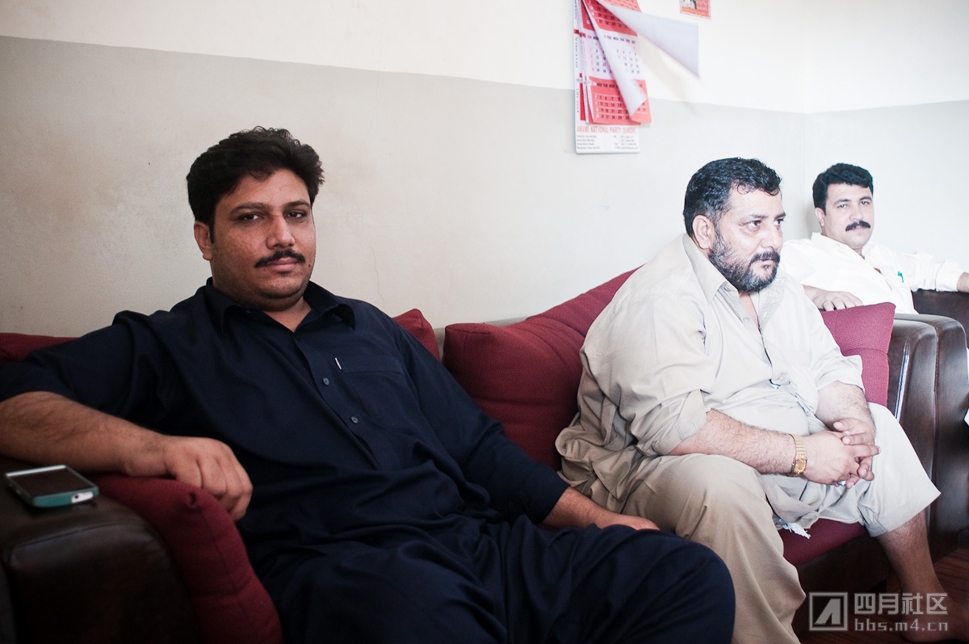
Khaksar Ali(左)是人民民族党希琳真纳地方办公室的负责人,这个集中了普什图民族主义者的组织控制着当地社区。在过去几十年里,尤其是在阿富汗战争之后,人民民族党在卡拉奇的影响力逐渐扩大。普什图人口数量大约为500万到600万人,是世界上最大的城市普什图聚居区。
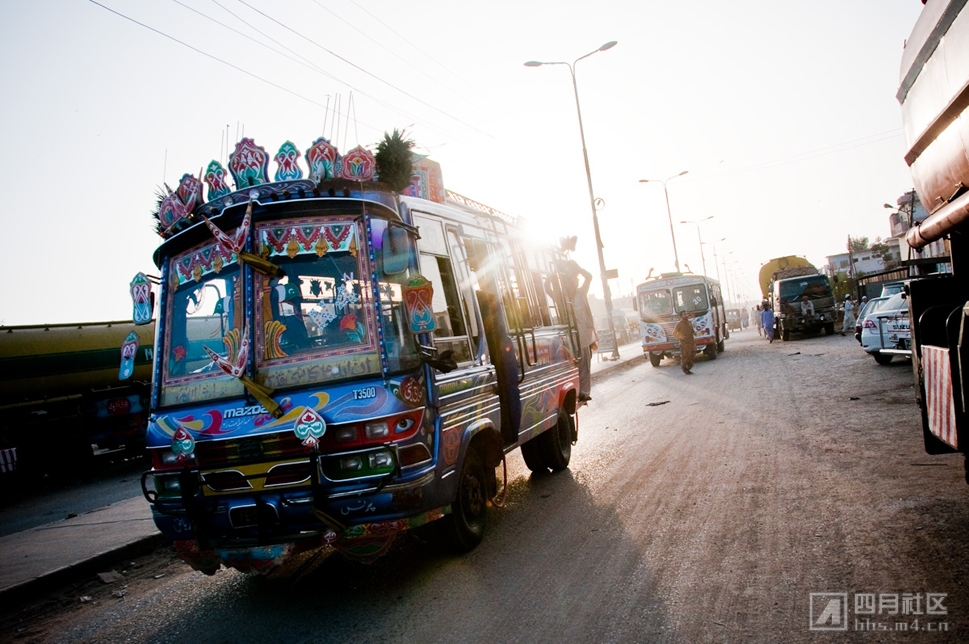
卡拉奇的私有公交系统,就像这辆五颜六色的汽车,被普什图人掌控。这些汽车有它们独特的装饰风格。
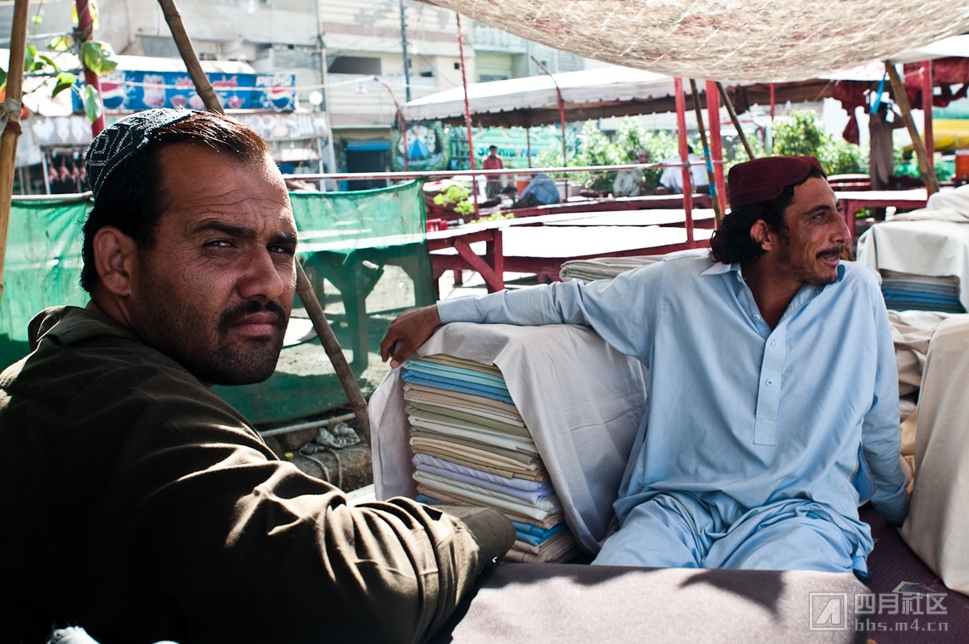
希琳真纳的卡车集散地挤满了各类商店、修理厂和小贩,向卡车司机兜售各种商品。Sayed(左)在他的流动摊位上出售衣服。他对艾金斯说:“如果人们都吃不饱饭,怎么会买衣服呢?”
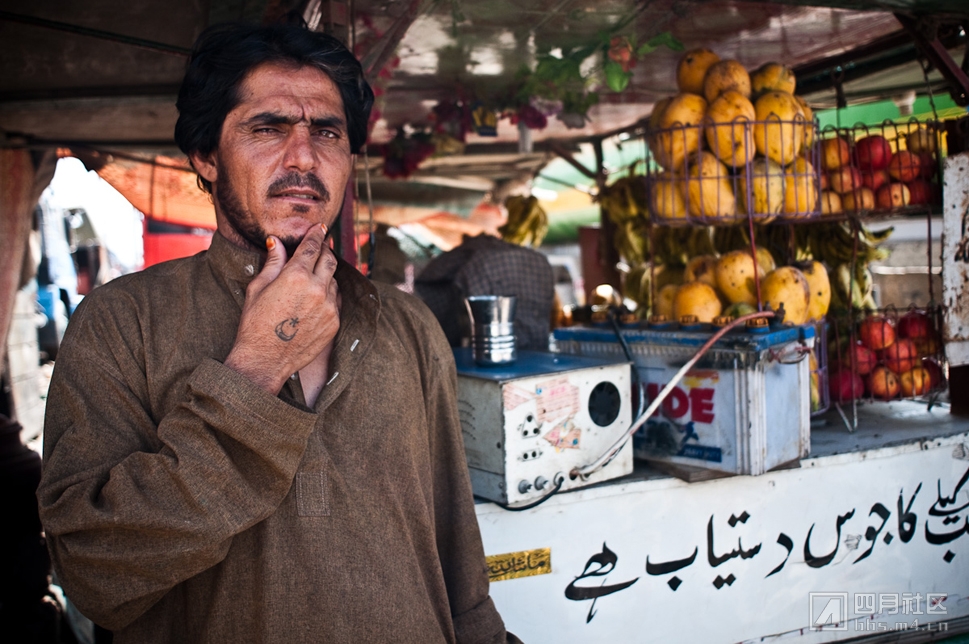
来自基达的Habibullah向希琳真纳的卡车司机买果汁。
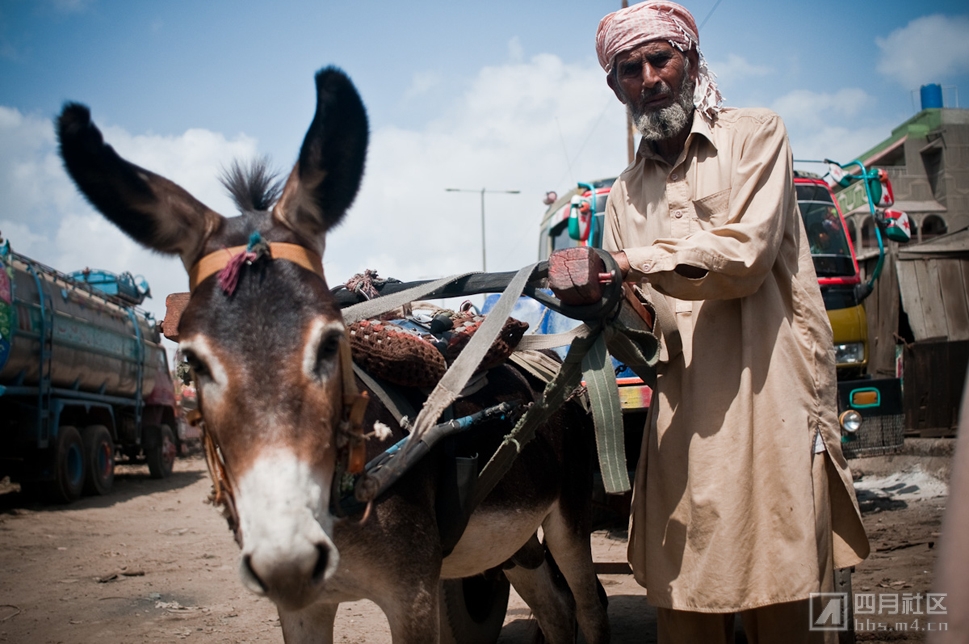
Din Muhammad和他的驴车向希琳真纳的卡车司机提供饮用水。

一个男孩在希琳真纳的街道上滚动一个轮胎。
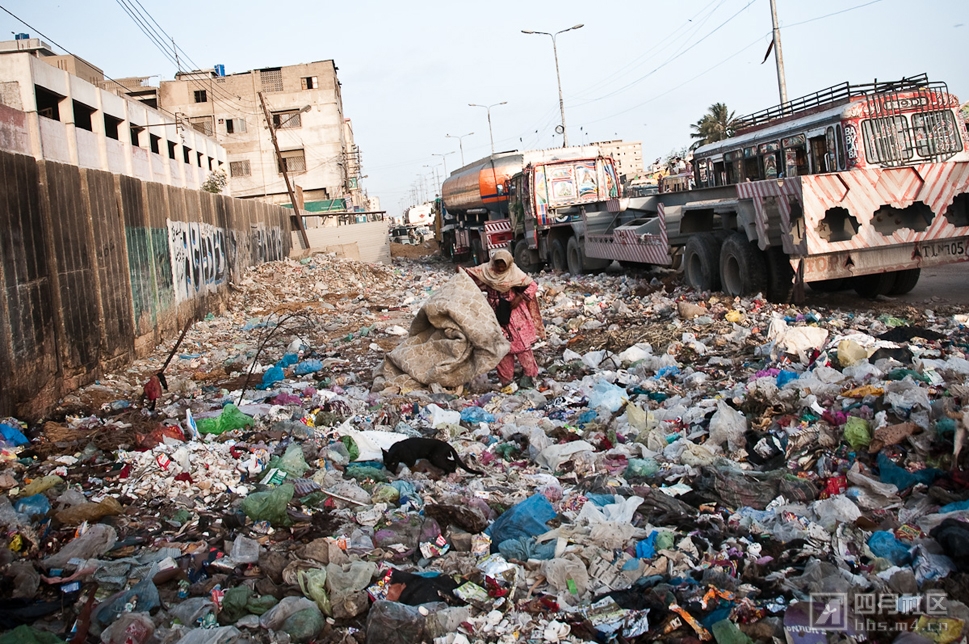
一个拾荒者在希琳真纳的垃圾堆中寻找。
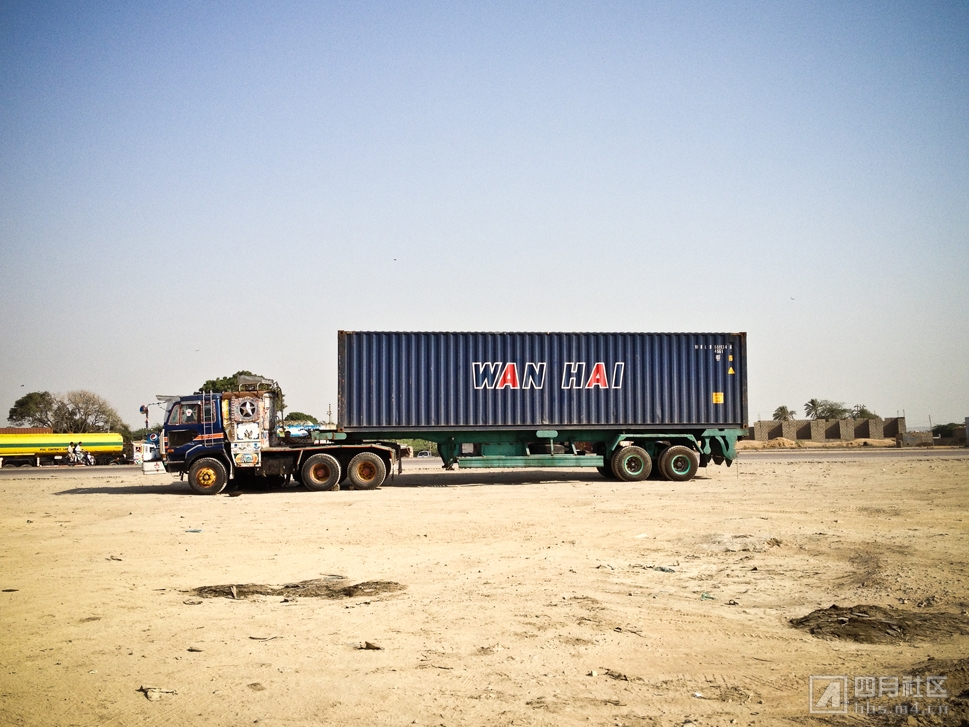
第二次来到卡拉奇的时候,艾金斯终于找到了两个愿意带他到阿富汗的司机——来自蓝地科托的普什图兄弟Jahangir和Ahmad。Jahangir在大约4年前购买了这辆1993年的尼桑柴油卡车。原来一直向北约后勤部运送汽油,道路封闭之后,兄弟俩开始运输民用品集装箱。
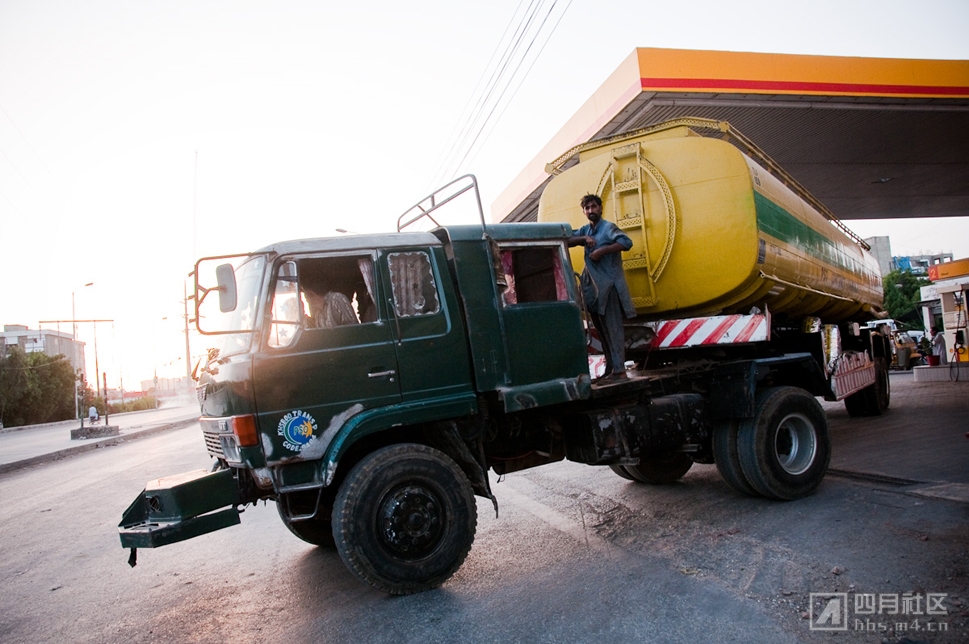
一辆油罐车从加油站驶向希琳真纳的主路。艾金斯和Jahangir、Ahmad以及一位修理工兼翻译Sardar离开卡拉奇之后才发现,大雨冲毁了信德西部的高速公路,截断了通往阿富汗的两条主干道其中之一——通往俾路支省和科加山口,然后进入阿富汗坎大哈的道路。艾金斯等人于是不得不取道白沙瓦,进入部落地区,那里原则上禁止外国人通行。然后设法穿过著名的开伯尔山口,进入阿富汗东部,前往喀布尔。
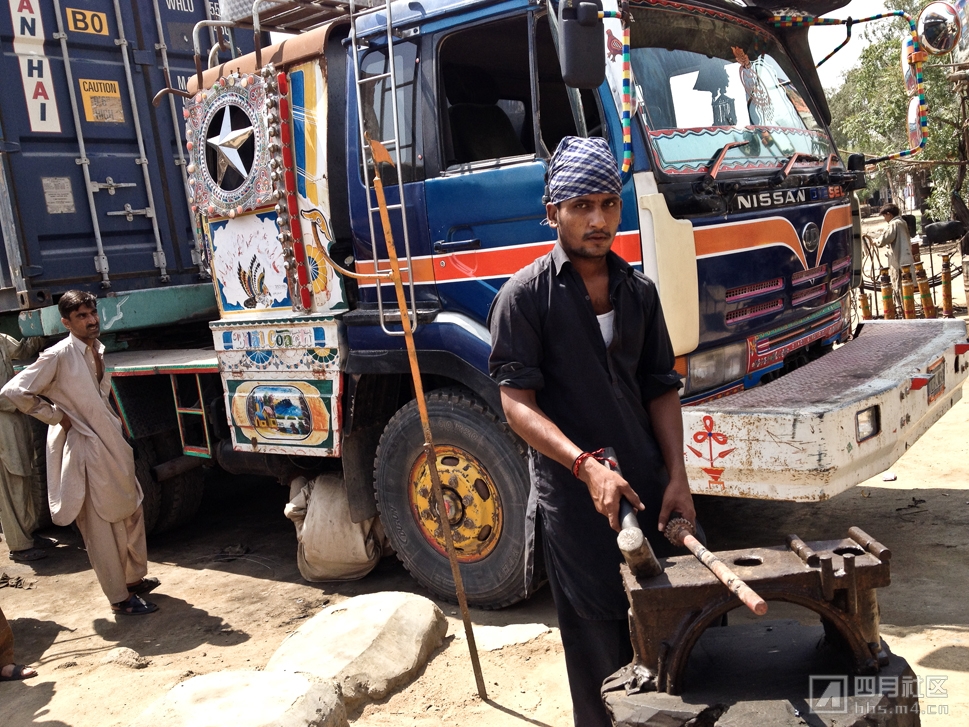
这次旅程长达1000英里,途中遍布向北约卡车司机索贿的警察。艾金斯写道,实际上,离开卡拉奇不远,“我们很快就了解到旅途中两个重大的挑战——贿赂和修车”。在向一个让他们停车的警察支付了一笔钱之后,他们需要在在信德省让图片上这个人修理一下排气筒。

飞驰过新赫和旁遮普省之后,一群人到达了边境地区的开伯尔普赫图赫瓦省,这个地名的意思是“开伯尔普什图之地”。卡拉奇到喀布尔的干道上,有很多卡车停靠点。两位司机在卡拉克小镇的一幅壁画下吃午餐。

距阿富汗边境30英里处的白沙瓦,经典的贝德福德卡车在雨后的道路上等待货物。贝德福德最早是在巴基斯坦建国之前,由英国人带到这里来的。

边境城镇蓝地科托的主山脉,坐落在巴基斯坦和阿富汗边境著名的开伯尔山口。艾金斯在Jahangir和Ahmad的家里度过一夜,那是一个泥砖砌的房屋,和十几个亲戚住在一起。半夜还和邻居发生了一点小摩擦。
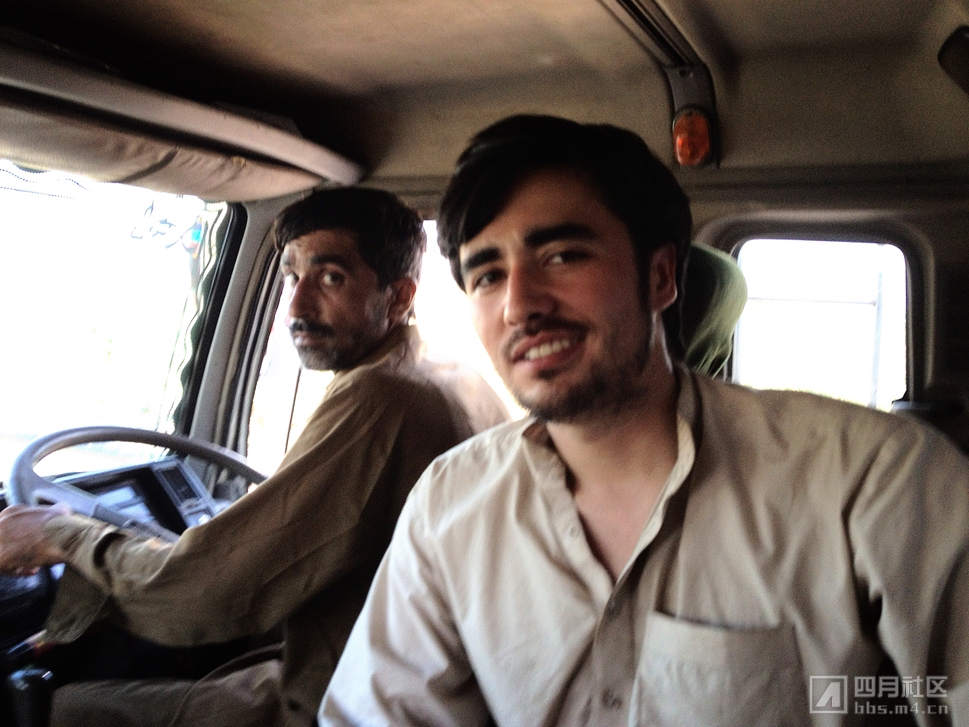
作者坐在卡车驾驶室里,他们走上通往托尔哈姆的6天旅程最后一段路。由于没有巴基斯坦政府发放的进入部落地区的证件,艾金斯不确定他是否能通过边境检查站。读读这本书《杰曼的鸟和开伯尔的花》,你就会知道他们的旅程最后如何结束。
原文:
How do you supply an entire war in landlocked Afghanistan? In the fall of 2012, award-winning Kabul-based journalist Matthieu Aikins found out firsthand, riding in a rickety 1993 Nissan truck along the U.S. supply route, from the port city of Karachi into Pakistan's scorching flatlands and lawless borderlands, through the famed Khyber Pass, and on toward the Afghan warzone. Along the way, Aikins meets shady Pakistani contractors, predatory police, and hawk-eyed toll guards, but also the rural Pashtuns who over the last decade have left their tribal homelands for trucking jobs in droves -- like the two hash-smoking brothers in whose cabin Aikins rode.
The result of Aikins's trip is his new ebook, Bird of Chaman, Flower of the Khyber -- the second in the Borderlands series from Foreign Policy magazine and the Pulitzer Center on Crisis Reporting, available on sale now -- as well as the photos here, taken by Aikins along his six-day, 1,000-mile ride.
Above: Pashtun truckers have a tradition of elaborately decorating their vehicles with brightly colored paint, embossed metal plates, and jingling chains hanging from the bumpers. Pictured here in Karachi is Omar Azaz, who is from the border town of Landi Kotal and works as a "conductor," or driving assistant, on this Nissan fuel tanker truck.
Aikins started his journey in Pakistan's largest city, Karachi, home to some 16 million people, where he sought out a trucker who would be willing to take him to Afghanistan. The aerial view above shows the main yard of the port city's Shireen Jinnah Colony, a neighborhood near the oil terminals where hundreds of tankers load up with fuel to supply the U.S. and NATO military presence in Afghanistan.
In 2011, the Pakistani government closed down the two main Afghanistan supply routes through Pakistan in response to an errant U.S. airstrike that killed 24 Pakistani soldiers. As a result, many truckers were left without work in Karachi for seven months. Here, Azim Khan, a tanker driver Aikins met in Shireen Jinnah in July 2012, stands atop his truck, where he slept every night during the supply line closure.
Thanks to the spike in demand for trucking that has accompanied the U.S. war in Afghanistan, particularly the surge that began in 2009, Shireen Jinnah has expanded rapidly in the past several years. Thousands of craftsmen and merchants -- largely Pashtuns who have migrated from the northwestern tribal areas -- depend on the trucking industry for their livelihoods.
Aikins first visited Karachi in the summer of 2012, two weeks after a deal was struck to reopen the routes, but with no luck finding a driver, he returned home to Kabul. When he returned to Karachi in the fall, container trucks had finally started moving supplies across the border, but the oil tankers and their drivers remained idle because of security concerns in the Pakistani tribal regions.
During the supply route closure, "people were desperately short on cash," Aikins writes in his book, "not only the truckers but the entire ecosystem that depended on their wages: trucking assistants, mechanics, tire salesmen, hotel owners, fruit vendors, truck artists, and butchers." In July, Azim Khan, the driver who slept in his truck, told Aikins: "Even the hashish dealers are suffering!"
Nasir Khan is an apprentice mechanic from the Pashtun border town of Landi Kotal who came to Karachi to find work.
Azim Khan sits inside the cab of his tanker truck.
Abdul Nisar, a Punjabi speaker from Lahore, sews seat upholstery in Shireen Jinnah. "Business was very good when NATO was running," he told Aikins.
Ibrahim is from Tank District, in northwest Pakistan, and sells tires in Shireen Jinnah. He told Aikins his business was down by half last year.
Sayed Saifullah (center) and his sons, Fareed, 18, and Syed Jahangir, 9, stand in front of their one-room, tire-jack shop. The boys' mother lives back in their village outside of Quetta; they share a one-room apartment with their father in Karachi.
A young Pashtun boy runs down the road in Shireen Jinnah. Thousands of Pashtuns have migrated from the tribal areas seeking work in Karachi, part of a larger pattern that has changed the city's ethnic balance and political leadership.
Khaksar Ali, left, is president of Shireen Jinnah's local office for the Awami National Party, a largely Pashtun secular nationalist group that controls the colony. The ANP has become increasingly powerful in Karachi over the past several decades, and especially since the war in Afghanistan, as the Pashtun population has grown to an estimated 5 to 6 million -- the world's largest urban Pashtun population.
Karachi's privately owned system of buses, like the colorfully ornamented one here, is dominated by Pashtuns. The vehicles bear their distinctive decorative style.
The area around the Shireen Jinnah truck lot is crammed with stores, workshops, and vendors that supply the truckers with everything they need. Sayed, left, sells cloth from his vendor cart. "If people can't afford to buy food, how can they buy clothes?" he told Aikins.
Habibullah, originally from Quetta, sells juice to the truckers of Shireen Jinnah.
Din Muhammad and his donkey haul drinking water to supply the truckers of Shireen Jinnah.
A boy rolls a tire through Shireen Jinnah.
A ragpicker goes through a trash pile in Shireen Jinnah.
One his second trip to Karachi, Aikins was finally introduced to two truckers willing to take him to Afghanistan: Jahangir and Ahmad, Pashtun brothers from Landi Kotal. Jahangir purchased their truck, the 1993 Nissan diesel hauler above, about four years ago. It originally brought fuel for the NATO supply lines, but when the line closure struck, the brothers switched to transporting private cargo containers.
An oil tanker truck pulls out onto the main road in Shireen Jinnah. By the time Aikins left Karachi with Jahangir, Ahmad, and his fixer and translator, Sardar, he discovered that heavy rains had flooded the highway west of Sindh, cutting off one of the two main truck routes into Afghanistan: a roadway that runs through the province of Balochistan and the Khojak Pass before crossing into Kandahar, Afghanistan. Instead, Aikins's crew would have to go up through Peshawar and into the tribal areas, which are generally off limits to foreigners, before crossing the famous Khyber Pass into eastern Afghanistan and onward to Kabul.
The route they set out on is about 1,000 miles long and is known for police who demand heavy bribes from NATO truck drivers. In fact, not far outside Karachi, the group "was quickly introduced to two of the trip's principal impediments: bribery and breakdown," Aikins writes. After paying off a cop who pulled them over, the men then had to get the truck's muffler repaired in Sindh province by the mechanic pictured here.
After making it through Sinh and then scorching Punjab, the group arrived in the border province of Khyber Pakhtunkhwa, which means "Land of the Khyber Pashtuns." Here, two truckers enjoy a meal under a mural in Karak, a town in the province, at one of the many truck stops that line the highways from Karachi to Kabul.
Classic Bedford trucks await their cargo in a rain-flooded neighborhood of Peshawar, about 30 miles from the Afghan border. Bedfords were originally brought to the region by the British prior to the creation of Pakistan.
The main valley of the border town of Landi Kotal, which sits at the top of the famous Khyber Pass between Pakistan and Afghanistan. Aikins spent a night at Jahangir in Ahmad's family compound in the town -- a mud-brick structure that houses dozens of their relatives -- where he had a close brush with an attack next door.
The author sits in the cab of the truck behind Jahangir as they enter the final pass to Torkham on their sixth day of travel. Without a certificate from the Pakistani government that would grant him permission to be in the restricted tribal areas, Aikins was unsure if he would be able to make it through the border checkpoints. Read his book -- Bird of Chaman, Flower of the Khyber -- to find out how his journey ends.
|
评分
-
1
查看全部评分
-
|
